Advantage of Premixed Mobile Phases for Consistent Chromatography of Peptides Using Nano-LC–MS/MS
Special Issues
High resolution mass spectrometry with nano-LC is used for protein identification and quantification in both top-down and bottom-up proteome analysis. Reliable instrumentation in combination with ultrapure mobile phases is essential for data integrity. Premixed 80% acetonitrile with 0.1% formic acid (LS122-500) and water with 0.1% formic acid (LS118-500) were designed to produce a consistent chromatographic performance using this instrument system. In this study, these mobile phases were used extensively to evaluate several factors which can affect separation of protein digests such as peak retention, peak repeatability, and sample carryover. Our results demonstrated excellent chromatographic performance using Thermo Scientific EASY-nLC 1200 LC system and Thermo Scientific LTQLX ™ ion trap mass spectrometer with the specialized premixed mobile phases.
High resolution mass spectrometry with nano-LC is used for protein identification and quantification in both top-down and bottom-up proteome analysis. Reliable instrumentation in combination with ultrapure mobile phases is essential for data integrity. Premixed 80% acetonitrile with 0.1% formic acid (LS122-500) and water with 0.1% formic acid (LS118-500) were designed to produce a consistent chromatographic performance using this instrument system. In this study, these mobile phases were used extensively to evaluate several factors which can affect separation of protein digests such as peak retention, peak repeatability, and sample carryover. Our results demonstrated excellent chromatographic performance using Thermo ScientificTM EASY-nLC 1200 LC system and Thermo ScientificTM LTQ-LXTM ion trap mass spectrometer with the specialized premixed mobile phases.
Proteomics involves the large-scale study of proteins, particularly their structures and functions. Analysis of intact proteins or top-down proteomics provides compositional information whereas bottom-up proteomics is a method to identify proteins and characterize their amino acid sequences and post-translational modifications by proteolytic protein digestion. High resolution mass spectrometry with nano-LC is widely used in both top-down and bottom-up proteomic analysis for protein identification and quantification. Reliable instrumentation in combination with high quality mobile phase is essential for data integrity. Accordingly, the EASY-nLC 1200 was designed to consistently provide up to 1200 bar pressure. Premixed 80% acetonitrile with 0.1% formic acid (LS122-500) and water with 0.1% formic acid (LS118-500) were developed in parallel to provide the EASY-nLC 1200 system with compatible ultrapure mobile phases in order to deliver excellent chromatographic performance.
Meding and colleagues (1) demonstrated that a premixed 80% acetonitrile with 0.1% formic acid mobile phase yields equal or better chromatographic performance for both early eluting and hydrophilic peptides. No negative effects, such as increased carryover or reduced long term stability, were observed. In the present study, the chromatographic performance resulting from use of LS122-500 and LS118-500 to resolve protein digests was evaluated based on peak repeatability, peak retention, peak full width at half maximum (FWHM), peak tailing factor, peak capacity, and sample carryover of early, middle, and late eluting peptides.
Experimental
Reagents
Mobile phase A is water with 0.1% formic acid (P/N LS118-500) and mobile phase B is 80% acetonitrile with 0.1% formic acid (P/N LS122-500), both reagents purchased from Fisher ScientificTM (Pittsburgh, PA). MassPREPTM Bovine Serum Albumin (BSA) digestion standard (P/N 186002329) was purchased from Waters Corp. (Milford, MA). BSA (1 nmol) was reconstituted in water with 0.1% formic acid to give the concentration of 100 femtomole/µL (fmol/µL).
Analytical column, Thermo ScientificTMAcclaimTM PepMapTM C18 100 Å, 2 μm particle size, 75 μm ID x 150 mm (P/N 164534), was equilibrated with 100 µL of water with 0.1% formic acid with maximum pressure at 980 bars. A sample pickup volume of 1 µL and a sample loading volume of 6 µL were used. Sample loading and equilibration were set at maximal pressure of 980 bars. The mobile phase gradient is as follows:
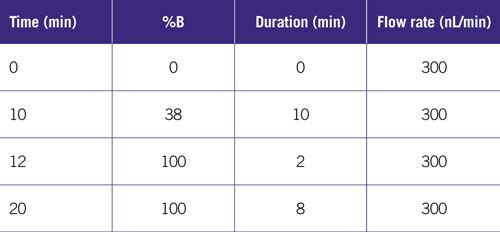
Instrument
The EASY-nLC 1200 was set up in one-column mode with loop volume of 20 µL, idle flow rate of 200 nL/min and idle mixture of 75% B. The column was connected to a venting tee through Thermo ScientificTM DionexTM nanoViperTM (P/N 6041.5240), a nanoViper union (P/N 6040.2304) and steel emitters (P/N ES542) (Figure 1).
Figure 1: One-column setup for the EASY-nLC 1200 system.

LTQ-LX MS Parameters
For MS detection, a LTQ-LX Ion trap with a Thermo ScientificTM EASY-SprayTM ion source was used. Full scan MS was performed in positive mode. The measurement mass range was 400–1200 m/z.
Source Voltage: 1.9 k
Vaporizer temp: 0
Sheath gas: 0
Aux gas: 0
Sweep gas: 0
Capillary temp: 200 °C
Tube Lens voltage: calibrated
Software
Thermo ScientificTM XcaliburTM 4.0 is used for the quantification of peptides.
Results and Discussion
To evaluate the performance of mobile phases, a sequence of 24 sample runs is setup in the following order: 2 blanks, 20 injections of 100 fmol BSA, 2 blanks. To obtain a statistical representative result, the same process was repeated in multiple instruments.
Retention time and peak area reproducibility were evaluated from 20 injections of 100 fmol BSA sample repeatedly from the same vial (Figure 2) in a fast mobile phase gradient. Five peptide peaks that are eluting at early, middle, and later part of the chromatogram from BSA digest were monitored by extracted ions at m/z 488.6, 722.5, 653.6, 582.5, and 508.0 (Figure 3). The results in Table I showed the relative standard deviation (RSD) of retention time is less than 0.3% except the first eluting peak which has a RSD of 0.57%. The RSD of peak area of all peptides is less than 10%. Slow mobile phase gradient can be applied if it is necessary in the complex matrix sample to achieve better qualitative and quantitative results.
Figure 2: Base peak chromatogram of BSA at 100 fmol.
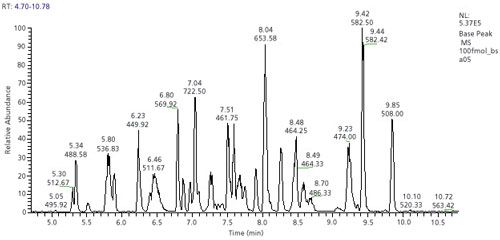
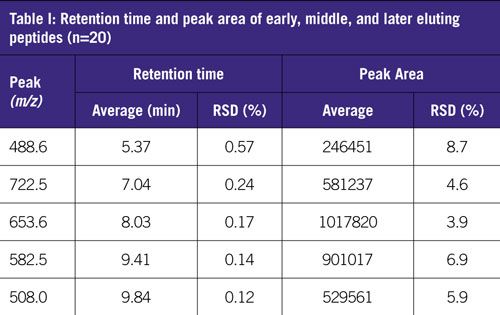
Figure 3: Overlay of eight injections of extracted ion chromatogram at m/z 488.6, 722.5, 653.6, 582.5, and 508.0.
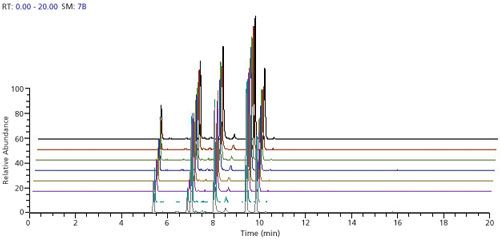
The peak width to calculate tailing factor is the width of the peak measured at 4σ (13.4% of the peak height) or at 5% of the peak height recommended by the FDA. The determination of tailing factor for EASY-nLC 1200 uses peak width at 13.4% of the peak height as illustrated below.

The parameters, a and b, are illustrated in Figure 4. The BSA peptides were each used in turn to determine tailing factor.
Figure 4: Diagram of tailing factor.
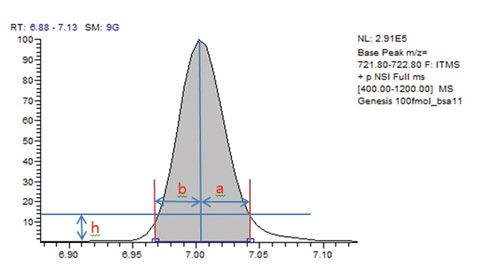
The maximal peak width and tailing factor cut off in the manufacture specification of EASY-nLC 1200 are 4 s and 1.5 s, respectively. The results in Table II showed that both peak width and tailing factor of all the peaks were well below the specification of EASY-nLC 1200 using premixed mobile phases LS122-500 and LS118-500. Tailing factor can have significant impact to resolution and detection limits. Peak tailing can be minimized by replacing both mobile phase and column.
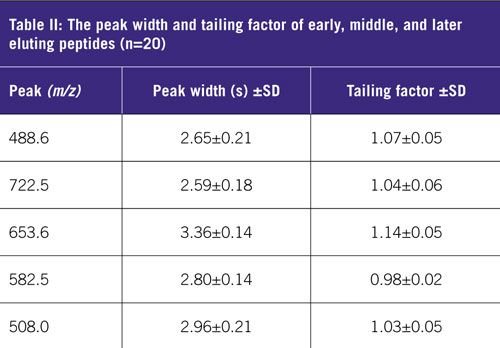
A good performance criterion for the gradient separation of peptides is peak capacity (Nc). Peak capacity refers to the number of peaks that can be separated and eluted in the applied gradient window. The peak capacity is determined using a simplified equation initially proposed by Dolan and colleagues (2) below:

where tR,n and tR,1 are the retention time of the last and the first real peak and W is the average peak width. W was estimated using the average peak width of five peptides measured at 4σ. The peak capacity was estimated to be 65± 6 from 10 different instruments. It is evident from Figure 2 that severe peak overlap exists for peptides eluted between 5 and 10 min. Gradient time, column temperature, flow rate, and mobile phase composition can significantly impact peak capacities. For example, using 0.1% TFA instead of 0.1% FA can significantly increase peak capacity by reducing the peak width. However, the use of TFA instead of FA causes a 12-fold decrease in MS signal (3). Wang and colleagues (4,5) demonstrated that under a great variety of experimental conditions, this peptide mixture provides a retention window as well as peak widths and thus an experimental peak capacity very similar to those obtained with the very complex set of peptides in a BSA tryptic digest. The results obtained are applicable to a typical tryptic digest peptide mixture. For a complex set of tryptic digest peptide mixture, 2–4-h gradient separation is recommended for protein identification.
To obtain statistical representative results, 10 different EASY-nLC 1200 instruments were set up separately to evaluate the effects of carryover using LS122-500. Sample carryover was measured by average peak area of residual peptide (YIC*DNQDTISSK, m/z 722.5) in the amount of 100 fmol BSA on column run divided by the peak area in an immediate subsequent blank 1 (BK1) and blank 2 (BK2) samples. Since LS122-500 is an 80% acetonitrile blend (usually the column wash is performed by 100% acetonitrile), a higher carryover is expected. Our analysis (Figure 5) clearly shows that the percent carryover in the amount of 100 fmol on column is well below the cut-off of 1% maximal carryover.
Figure 5: The percent carryover of peptide at m/z 722.5 in 10 different instruments.
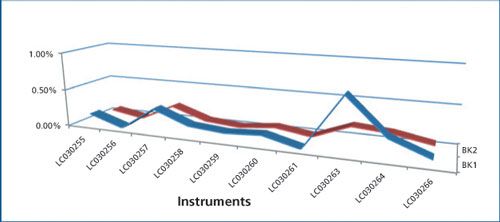
Contamination as opposed to carryover has a tendency to be more random. Polyethylene glycol (PEG) in all its variants should be considered in detail. From the spectrum at RT 9.38 min, it suggested m/z at 415 (M+H)+, 432 (M+NH4)+, and 437 (M+Na)+ to be potential PEG contamination. Similarly, m/z at 459, 476, and 481 at RT 9.78 min and m/z 503, 520, and 525 at RT 10.13 min with repeating units of 44 Da, in comparison to spectrum at RT 9.38 min, are potential PEG contamination with different chain lengths (Figure 6). The percent PEG contamination in this system was calculated to be 0.6%. The system was cleaned with 100% methanol and potential PEG contamination was removed (data not shown). To further test whether PEG contamination was from the mobile phase, the same mobile phase LS122-500 and LS118-500 was tested in different EASY-nLC 1200 instruments, and PEG peaks were not detected, suggesting the PEG impurities detected in one system were not from mobile phase solution.
Figure 6: Spectra at retention times of 9.38 min, 9.78 min, and 10.13 min obtained in one instrument suggest potential PEG contamination.
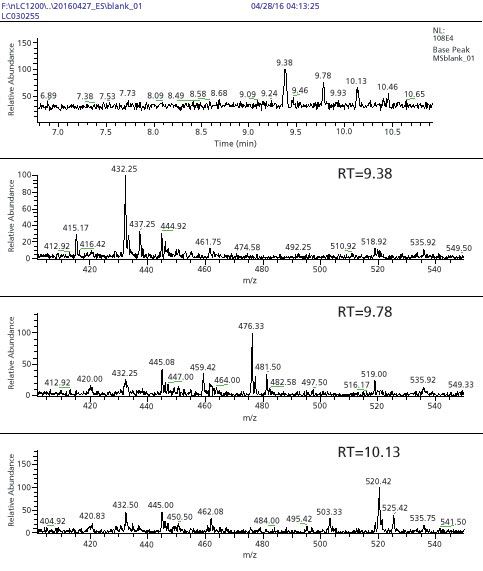
Figure 7: Relative retention times with RSD of all peptides from five different instruments. Each data point is the average of 20 injections at 100 fmol BSA.
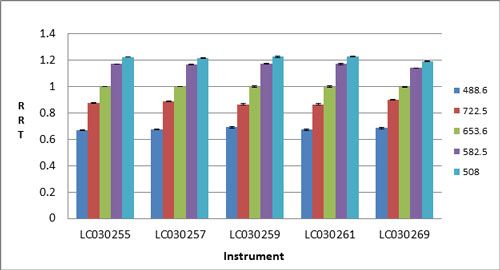
To evaluate the mobile phase shelf life after opening the bottle, retention time of the peaks was monitored. Once the bottle is opened, organic mobile phase may evaporate which can result in retention time shift. Reproducibility of retention time of the peptide peaks was evaluated using five different systems during a two-week time period. Due to dead volume difference among instruments, relative retention time (RRT) of all the peptides and their relative standard deviation were determined. The use of RRT reduces the effects of some of the variables from different systems that can affect retention time.
Conclusion
Retention times and peak areas in early, middle, and later eluting peptides are consistent in 20 consecutive injections from multiple EASY-nLC 1200 instruments using LS122-500 and LS 118-500 as mobile phases.
Sample carry over evaluated in 10 different EASY-nLC 1200 instruments using premixed mobile phases was significantly below instrument specification.
Polyethylene glycol contamination was observed in one EASY-nLC 1200 with LTQ-LX ion trap system, but it was confirmed that contamination was not from the mobile phase.
Peak width and tailing factor of EASY-nLC 1200 using premixed mobile phases were well below instrument specification.
Mobile phase evaluated in multiple instruments based on relative retention time suggested that the shelf life stability of LS122-500 is at least two weeks after the premixed mobile phase bottle is opened and closed repeatedly following good laboratory practice.
References
- S. Meding, A. Paulus, and R. Swart, Thermo Fisher Scientific application note 637 (2015).
- J.W. Dolan, L.R. Snyder, N.M. Djordjevic, D.W. Hill, and T.J. Waeghe, J. Chromatogr. A.857, 1–20 (1999).
- M.A. Lauber, S.M. Koza, and K.J. Fountain, Waters application note 720004568EN (2013).
- X. Wang, W.E. Barber, and P.W. Carr, J. Chromatogr. A. 1107, 139–151 (2006).
- X. Wang, D.R. Stoll, A.P. Schellinger, and P.W. Carr, Anal. Chem.78(10), 3406–3416 (2006).
For more information on pricing and availability of LC-MS reagents go to http://fishersci.com/chemicals

Thermo Fisher Scientific
355 River Oaks Parkway, San Jose, CA 95134
tel. (800) 532-4752
Website: www.thermofisher.com
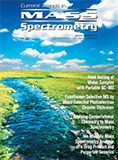
Smarter Sensors, Cleaner Earth Using AI and IoT for Pollution Monitoring
April 22nd 2025A global research team has detailed how smart sensors, artificial intelligence (AI), machine learning, and Internet of Things (IoT) technologies are transforming the detection and management of environmental pollutants. Their comprehensive review highlights how spectroscopy and sensor networks are now key tools in real-time pollution tracking.